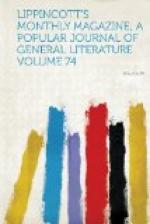Before finally joining with M. Halevy, M. Meilhac wrote two comedies in five acts of high aim and skilful execution, and two other five-act pieces have been written by MM. Meilhac and Halevy together. The Vertu de Celimene and the Petit fils de Mascarille are by the elder partner—Fanny Lear and Froufrou are the work of the firm. Yet in these last two it is difficult to see any trace of M. Halevy’s handiwork. Allowing for the growth of M. Meilhac’s intellect during the eight or ten years which intervened between the work alone and the work with his associate, and allowing for the improvement in the mechanism of play-making, I see no reason why M. Meilhac might not have written Fanny Lear and Froufrou substantially as they are had he never met M. Halevy. But it is inconceivable that M. Halevy alone could have attained so high an elevation or have gained so full a comic force. Perhaps, however, M. Halevy deserves credit for the better technical construction of the later plays: merely in their mechanism the first three acts of Froufrou are marvellously skilful. And perhaps, also, his is a certain softening humor, which is the cause that the two later plays, written by both partners, are not so hard in their brilliance as the two earlier comedies, the work of M. Meilhac alone.
It may seem something like a discussion of infinitesimals, but I think M. Halevy’s co-operation has given M. Meilhac’s plays a fuller ethical richness. To the younger writer is due a simple but direct irony, as well as a lightsome and laughing desire to point a moral when occasion serves. Certainly, I shall not hold up a play written to please the public of the Palais Royal, or even of the Gymnase, as a model of all the virtues. Nor need it be, on the other hand, an embodiment of all the cardinal sins. The frequenters of the Palais Royal Theatre are not babes; young people of either sex are not taken there; only the emancipated gain admittance; and to the seasoned sinners who haunt theatres of this type these plays by MM. Meilhac and Halevy are harmless. Indeed, I do not recall any play of theirs which could hurt any one capable of understanding it. Most of their plays are not to be recommended to ignorant innocence or to fragile virtue. They are not meant for young men and maidens. They are not wholly free from the taint which is to be detected in nearly all French fiction. The mark of the beast is set on not a little of the work done by the strongest men in France. M. Meilhac is too clean and too clever ever to delve in indecency from mere wantonness: he has no liking for vice, but his virtue sits easily on him, and though he is sound on the main question, he looks upon the vagaries of others with a gentle eye. M. Halevy, it seems to me, is made of somewhat sterner stuff. He raises a warning voice now and then—in Fanny Lear, for instance, the moral is pointed explicitly—and even where there is no moral tagged to the fable, he




